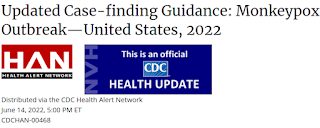
#16,822
Late yesterday the CDC updated their Monkeypox Guidance (see May 20th HAN#00468) in a HAN (Health Alert Network) release aimed at clinicians and public health officials. When the initial guidance was released, relatively little was known about Atypical Monkeypox Presentations, or the epidemiology of this outbreak.
Yesterday's HAN update focuses on case recognition and the reporting of cases.
Due to its length I've only excerpted some highlights. Follow the link to read the release in its entirety.
Updated Case-finding Guidance: Monkeypox Outbreak—United States, 2022
Distributed via the CDC Health Alert Network
June 14, 2022, 5:00 PM ET
CDCHAN-00468
Summary
Since May 2022, monkeypox cases, which have historically been rare in the United States, have been identified in 18 states and territories among both persons returning from international travel and their close contacts domestically. Globally, more than 1,600 cases have been reported from more than 30 countries; the case count continues to rise daily. In the United States, evidence of person-to-person disease transmission in multiple states and reports of clinical cases with some uncharacteristic features have raised concern that some cases are not being recognized and tested.
This Health Alert Network (HAN) Health Update serves to alert clinicians to clinical presentations of monkeypox seen so far in the United States and to provide updated and expanded case definitions intended to encourage testing for monkeypox among persons presenting for care with relevant history, signs, and symptoms. In addition, this Health Update provides an update to a HAN Health Advisory that the Centers for Disease Control and Prevention (CDC) issued May 20, 2022 titled Monkeypox Virus Infection in the United States and Other Non-endemic Countries—2022.In people with epidemiologic risk factors, rashes initially considered characteristic of more common infections (e.g., varicella zoster, herpes, syphilis) should be carefully evaluated for concurrent characteristic monkeypox rash (see images and links to below) and considered for testing.(SNIP)
Updated Case Definitions
- On June 1, 2022, CDC updated and expanded its monkeypox case definitions to ensure that anyone who is suspected of having monkeypox can be tested and appropriate steps to protect contacts can be taken.
- Revised categories of suspected, probable, and confirmed cases of monkeypox standardize case reporting through the National Notifiable Diseases Surveillance System (NNDSS). In addition, the “suspected” case definition encourages broader suspicion for monkeypox.
* The characteristic rash associated with monkeypox lesions involves the following: deep-seated and well-circumscribed lesions, often with central umbilication; and lesion progression through specific sequential stages: macules, papules, vesicles, pustules, and scabs. The rash can sometimes be confused with other diseases that are more commonly encountered in clinical practice (e.g., syphilis, herpes, and varicella zoster). Historically, sporadic accounts of patients co-infected with Monkeypox virus and other infectious agents (e.g., varicella zoster, syphilis) have been reported; so patients with a characteristic rash should be considered for Monkeypox virus testing, even if tests for other infectious agents are positive.
† Clinical suspicion may exist if lesions consistent with those from more common infections (e.g., syphilis, herpes, and varicella zoster) co-exist with lesions that may be characteristic of monkeypox.
Clinical presentations of confirmed cases to dateDescriptions of classic monkeypox disease describe a prodrome including fever, lymphadenopathy, headache, and muscle aches followed by development of a characteristic rash culminating in firm, deep-seated, well-circumscribed and sometimes umbilicated lesions. The rash usually starts on the face or in the oral cavity and progresses through several synchronized stages on each affected area and concentrates on the face and extremities, including lesions on the palms and soles.
Thus far in the U.S. outbreak, all patients diagnosed with monkeypox in the United States have experienced a rash or enanthem. Although the characteristic firm, deep-seated, well-circumscribed and sometimes umbilicated rash has been observed, the rash has often begun in mucosal areas (e.g., genital, perianal, oral mucosa) and in some patients, the lesions have been scattered or localized to a specific body site rather than diffuse and have not involved the face or extremities. In some instances, patients have presented with symptoms such as anorectal pain, tenesmus, and rectal bleeding which upon physical examination, have been found to be associated with visible perianal vesicular, pustular, or ulcerative skin lesions and proctitis. The lesions have sometimes been in different stages of progression on a specific anatomic site (e.g., vesicles and pustules existing side-by-side), In addition, prodromal symptoms including fever, malaise, headache, and lymphadenopathy have not always occurred before the rash if they have occurred at all.
The clinical presentation of monkeypox may be similar to some STIs, such as syphilis, herpes, lymphogranuloma venereum (LGV), or other etiologies of proctitis. Clinicians should perform a thorough skin and mucosal (e.g., anal, vaginal, oral) examination for the characteristic vesiculo-pustular rash of monkeypox; this allows for detection of lesions the patient may not have been previously aware of. The search for lesions consistent with monkeypox should be performed even if lesions consistent with those from more common infections (e.g., varicella zoster, syphilis, herpes) are observed; this is particularly important when evaluating patients who have epidemiologic risk factors for monkeypox.Specimens should be obtained from lesions (including those inside the mouth, anus, or vagina) and tested for monkeypox.
Any patient who meets the suspected case definition should be counseled to implement appropriate transmission precautions. Probable and confirmed case-patients should remain in isolation for the duration of their infectious period (i.e., until all lesions have resolved, the scabs have fallen off, and a fresh layer of intact skin has formed). Patients who do not require hospitalization but remain potentially infectious to others should isolate at home. This includes abstaining from contact with other persons and pets, and wearing appropriate personal protective equipment (e.g., clothing to cover lesions, face mask) to prevent further spread.
The unusual presentation and rapid spread of Monkeypox will make containment difficult, and the WHO will reportedly convene their Emergency Committee next week to discuss whether this outbreak rises to the level of a PHEIC (Public Health Emergency of International Concern).
